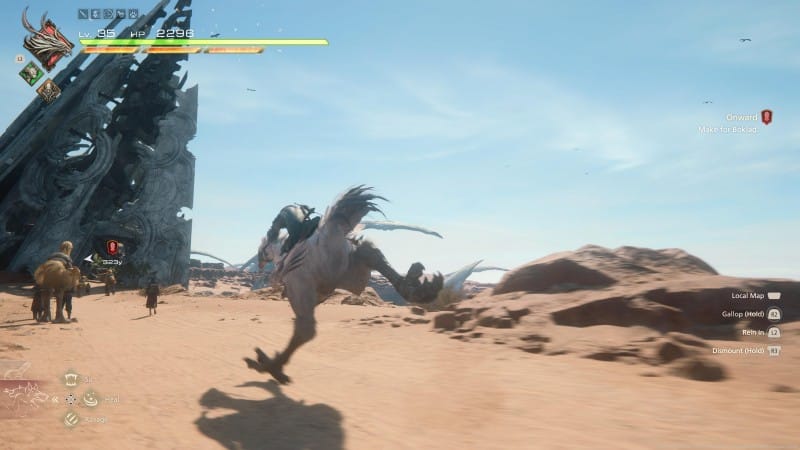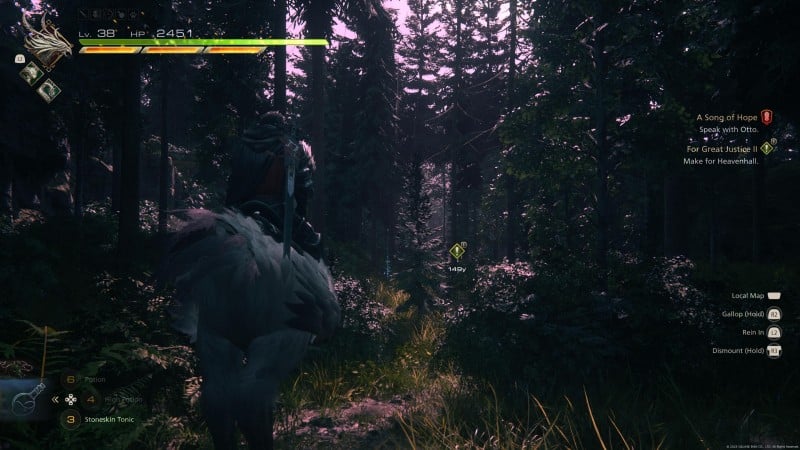
Victory In The Land Of Gods And Monsters
Final Fantasy XVI is extravagant, self-indulgent, and exaggerated, exceeding my expectations for what an action-oriented Final Fantasy could accomplish. It represents a pivotal change for the series, abandoning any semblance of turn-based move selection, active-time battles, or anything else in its history in favor of a fast-paced, extravagant, combo-heavy combat system that grew increasingly comprehensive over the course of my 60-plus hour voyage.
In Final Fantasy XVI, there is a linear action game that is the highlight of the experience. An otherwise combustible narrative about gods, Eikons, crystals, and the meaning of free will is slowed by standard RPG tropes, mechanics, and the game’s more open nature outside of story-based dungeon objectives. Still, Final Fantasy XVI’s peaks are among the highest in the series and action titles in general.
FFXVI’s tagline reads, “The legacy of the crystals has shaped our history for far too long.” It is a theme that will be discussed and referred to throughout the game. Narratively, the protagonist Clive Rosfield and his band of outlaws, which includes Cid, Jill, and a large number of other cast members, are revolutionaries. In multiple ways, they intended to demolish the pillars of Valisthean society that have only grown stronger over time, in an effort to reshape life on the continent.
The story begins as a tale of vengeance set against the backdrop of enslavement; in Valisthea, magic-using Bearers are enslaved, traded, and sold to whoever needs them. FFXVI fails to say anything new or remarkable on this front, a failure made all the more conspicuous by the lack of people of color in its principal cast. The largest flaw of Final Fantasy XVI is its majority-white cast that comments on and fights against slavery and the systems that sustain it, with little insight or representation from the types of real-world people who are frequently affected by slavery.
Eventually, the narrative focuses on other, more general foundations of Valisthean society that must be overthrown. Here is where the story truly emerges. Though occasionally a bit too similar to its Game of Thrones inspiration to feel truly original, the voice talent behind these characters commits to every cadence, and it succeeds. Final Fantasy aficionados and admirers of series such as Kingdom Hearts who appreciate corny love tales (both romantic and platonic) will enjoy how FFXVI unfolds.
The story of Final Fantasy XVI is bolstered by a visual style that is stunning at times, although there are areas where I am less than impressed and even dismayed. NPC models, especially those of non-main characters, are frequently made of plastic and contrast starkly with the primary cast. Performance mode has difficulty reaching 60 FPS, and even when it does, it is inconsistent.
FFXVI is significantly more stylized than realistic; it is very “medieval Final Fantasy.” When the visual elements, such as the user interface, environments, and combat effects, come together, the visual presentation emerges. However, it can be difficult to see through the clutter and comprehend what is happening.
The least remarkable features are the open-field areas. Large but largely forgettable voids, save for the occasional side objective, stray treasure, or multitude of foes. Their emptiness exemplifies my biggest issue with Final Fantasy XVI – it is an outstanding action game, but not as an RPG. There are dozens of crafting materials, but I cannot name one because crafting in Final Fantasy XVI is more of a concept than a system. There are no weapons that function better with this or that sort of construct; only the deadliest weapon exists, and it’s evident that you should craft it. And with the exception of a few endgame firearms, you will always have the necessary materials if you complete narrative missions and the odd side objective. The same applies to other items of equipment.
It is with the Eikonic powers that Final Fantasy XVI’s RPG mechanics come into action. As Clive acquires the abilities of more Eikons over the course of the narrative, he receives access to new abilities, allowing you to reconfigure his design. I fell in love with my Phoenix-Garuda-Bahamut combination in particular. This was enhanced by additional accoutrements, such as one that reduced the cooldown of my powerful Phoenix attack by 12 seconds. But apart from these abilities and accoutrements, FFXVI’s linearity is disappointing for an RPG. The preponderance of weapons, accoutrements, and abilities will presumably be available to players who attain the credits. The diversity of playstyles is determined by how they are combined.
Side pursuits are almost always some variance of retrieval quests. Communicate with this individual, proceed to this location, and attack some foes before returning for your recompense. And while this is not always the case, the majority of them contain a surprising amount of dialogue and detail, and they are generally enjoyable to read. Creative Business Unit III introduces a quality-of-life feature I’d like to see in every role-playing game: secondary missions marked with a plus symbol will recompense you with something other than gil or resources upon completion. This was how I knew to complete the side objectives that rewarded me with an increased potion inventory, increased potion potency, and even a Chocobo mount.
In addition, many of these side quests build upon one another, and as these tales proceed, I appreciate how they bring the encompassing world to life. This was a particularly welcome sensation given that Clive is engaged in battle and Final Fantasy XVI spans decades. Observing how the world outside of Clive’s mission evolves visually and narratively over time gives my actions added weight.
However, the tempo and content of these side objectives, as well as everything that occurred outside of the main missions, are simply inferior to those of the main missions, and as a result, they feel significantly sluggish and less thrilling. I enjoy collecting new tunes for my Hideaway’s orchestration jukebox and visiting the loresman Harpocrates to learn more about Valisthea, but these side activities frequently felt more like a chore than something I wanted to do.
Possibly, this is the idea. Clive and the group require downtime after completing narrative objectives – missions that constantly left me in amazement, tingling covering my limbs – but just because the characters need downtime doesn’t mean I want it. It’s not that everything that occurs outside of the primary narrative is repetitive; rather, what Creative Business Unit III does in those story assignments is so fantastic that I was constantly racing to the next one.
I’m not exaggerating when I say that there was a moment in Final Fantasy XVI, a final battle that lasted for what seemed like an hour, that I consider to be my favorite in the series, and perhaps even in all of gaming. It is memorable and conveys Creative Business Unit III’s confidence and command of the brand. The fact that this moment is nearly surpassed by another later in the game is indicative of FFXVI’s extreme highs, which highlight the fine and predictable bloated lows of a Final Fantasy RPG.
There are a number of causes for why these peaks are so tall. Creative Business Unit III has developed my preferred action combat system up to this point. It is quick and straightforward on the surface. However, it has a great deal of substance, and your ability to progress will depend on your willingness to engage with its numerous systems. The addition of Eikonic abilities intensifies the action, and I was able to defeat even the most formidable foes by relying on specific ability combinations. Controlling the Ifrit Eikon during setpiece moments was not as varied from a gameplay standpoint as I would have preferred, but the spectacle surrounding these moments more than makes up for it.
Those familiar with FFXIV will not be surprised to learn that the FFXVI score by composer Masayoshi Soken nearly outshines every other aspect of the game. And I don’t say that to diminish your expectations about playing the game and what awaits you; I say it to raise your expectations for Soken’s score, which includes new personal favorites from the expansive Final Fantasy catalog. Multiple times throughout FFXVI’s duration, Soken deftly demonstrates why he is a fan-favorite Final Fantasy composer by alternating between gentle piano notes and robust chorus-backed epics that encompass entire sequences.
With over 65 hours of Final Fantasy XVI under my belt, there’s still a lot to do outside of the story, and I’m pleased my time with Creative Business Unit III’s latest isn’t over yet. FFXVI contains some of my favorite modern Final Fantasy moments, but its low points threaten to slow their arrival. I wish Final Fantasy XVI’s diverse elements were more seamlessly integrated. When I reflect on my time with Clive, his allies, his adversaries, and Valisthea, I vividly recall the high points. FFXVI is very different from its antecedents, but in many ways it feels very familiar; it’s still a Final Fantasy through and through, reaffirming me why I adore this series so much.
Quick Links
© 2024 lovegame247.com - All Rights Reserved







.webp)




.webp)
.webp)